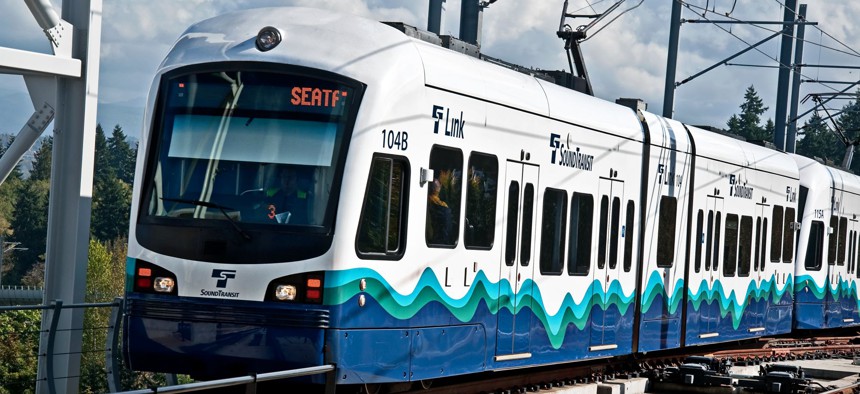Connecting state and local government leaders
Yes, mobility is important, but every dollar invested to improve infrastructure is also a dollar invested in being better prepared for the next major disaster.
SEATTLE — When investments in transportation infrastructure are normally being discussed, they’re looked at through the lens of mobility. And that’s for a very good reason: Improving the way you can get from Point A to Point B to Point C and beyond should be the driving force behind transportation investments.
The Pacific Northwest’s largest city is currently basking in the glow of attention from the national urbanist community following local voters approving a $54 billion plan to expand the already growing Sound Transit Link light-rail system in order to connect more areas within Seattle and in neighboring jurisdictions, among other transportation improvements.
Beyond investments in mobility, the Seattle area’s transit expansion program has other benefits, primarily economic development and environmental. (Building the nation’s largest battery-electric bus fleet, as King County Metro is doing in Seattle, is something worthy of national attention, too.)
But there’s something very important about the forthcoming infrastructure improvements that Seattle and its surrounding region shouldn’t overlook and that other states and local jurisdictions outside the Pacific Northwest shouldn’t ignore either regarding their own transportation planning: Resiliency.
The infrastructure that supports the Link light-rail system, which will eventually connect Seattle with Tacoma in the south and Everett in the north, is being built to a high design standard meant to survive very powerful earthquakes, which is important in the seismically active Pacific Northwest.
Light-rail trains should be operational immediately following a moderate seismic event, like the 6.8 magnitude Nisqually earthquake in 2001, assuming that trackways are clear and power isn’t disrupted.
Last summer, Seattle Transit Blog took a look at the seismic readiness of the Link light-rail system and Sound Transit spokesman Bruce Gray detailed some of the what ifs, including what is likely to happen in a future 9.0 magnitude Cascadia megathrust earthquake, a regional disaster that will cripple transportation and other critical infrastructure across the Pacific Northwest:
It’s designed to avoid major failure and maintain life safety after the worst earthquake that experts can predict will happen every 2,500 years or so. I[n] this scenario Link would likely not be operational because of track blockages or power disruptions but the infrastructure would be standing. Backup systems would be able to power fire/life/safety systems in our underground stations but they would not be able to power the line.
In that worst-case scenario, the Link system is expected to be knocked offline in the near term, but it won’t be destroyed like, say, many of the bridges the Washington State Department of Transportation currently needs to retrofit or rebuild—especially many spans along Interstate 5 that were built atop hollow columns and are at significant risk of imploding in a major seismic event.

In the Pacific Northwest (and elsewhere), seismic preparedness is often measured in the number of vulnerable buildings retrofitted, the amount of emergency supplies residents need to stockpile to survive until help arrives and the scope of resources emergency managers have assembled and are ready to deploy immediately following the quake. On Tuesday, Washington Gov. Jay Inslee will assemble his resiliency subcabinet in Olympia to discuss progress on the state’s preparedness and response to effectively deal with the next major disaster.
But leaders here and elsewhere around the U.S. need to think about long-term resiliency, too. And that’s where smart investments in transportation infrastructure are critically important.
Last year, emergency managers in the Carolinas and Louisiana were dealing with significant sections of interstate highway that were flooded from high-precipitation storm events, underscoring the need to rethink whether current infrastructure is resilient enough to deal with future challenges from extreme weather events. These events highlight important deficiencies that can be hopefully addressed and rectified.
Simply put, every dollar invested in improving transportation infrastructure is a dollar that’s also invested in being better prepared for the next major disaster and the difficult recovery that will follow.
Yes, Link trains likely won’t be up and running following a Cascadia-type megathrust earthquake scenario, but the Sound Transit light-rail system’s major infrastructure assets should survive and can be repaired to get people moving through a congested region that will be even more congested when critical sections of roadway infrastructure, including Interstate 5, are sidelined or destroyed.
In Seattle, the expansion of the Link light-rail system in the coming years will include new crossings of the Lake Washington Ship Canal and the Duwamish Waterway that will, presumably, be built to same 2,500-year seismic standard as the existing system, giving the city and region additional connections needed for disaster recovery.

Less than 200 miles miles to the south in Oregon, transportation officials in Portland opened the new Tilikum Crossing of the Willamette River for light-rail trains, pedestrians and bicyclists. While many urbanists in Portland and elsewhere have pointed to that project, which opened in 2015, as something boosts mobility options in the Rose City, the Tilikum Crossing was also built to survive major earthquakes.
When the next major quake destroys many of Portland’s iconic but aging bridges over the Willamette River, many residents will be thankful that their leaders built the new Tilikum Crossing when infrastructure failures split the city in two.
During the long earthquake recovery in the Puget Sound region, Seattle-area residents will similarly be thankful that they authorized the construction of resilient infrastructure that will help the region in a long and difficult recovery, whenever the next major seismic disaster strikes. Voters may have OK’d major investments in mobility, but at the same time, they also gave the green light to significant investments in resiliency. That shouldn’t be overlooked.
In the campaign to promote the $54 billion plan, regional leaders and transit advocates pushing the mobility benefits didn’t really promote the proposal’s resiliency benefits. While that didn’t matter in the end—the Sound Transit 3 proposal passed with a comfortable margin—resiliency should be an important topic of public discourse when discussing major infrastructure investments. (Hopefully, the full light-rail system can be built out before the Really Big One strikes. Fingers crossed.)
Leaders in and around Seattle can’t afford to be timid when facing the very real threats of a seismic disaster that will, someday, bring the Pacific Northwest to its knees. When facing those looming threats, they shouldn’t look at transportation simply through the lens of mobility. Infrastructure plays a much larger and important role than that.
Michael Grass is Executive Editor of Government Executive’s Route Fifty and is based in Seattle. In 2002, he worked as a consultant on a Federal Transit Administration emergency preparedness program for first responders and local transit agencies.

NEXT STORY: DOD grants Level 5 authorization for Azure, Office 365




